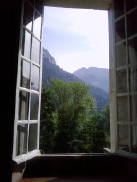The idea that geometry in Gothic architecture was used to structure ideas, rather than the edifice itself, has come up before here at Mathematics Rising. But I would like to focus a bit more on this today because it illustrates something about mathematics, and mathematics’ potential, that the modern proliferation of information may be obscuring. […]
|
|||||
|
I read a short article on scientificamerican.com reporting on a recent advance in the investigation of the neural systems that support navigation, or our sense of direction. When I did some follow-up on the individual who led the study, I was surprised to find another interesting collaboration between scientists and artists. While the collaboration was […] I thought recently, again, about the relationship between the written word and mathematical notation, both being systems of marks that carry meaning. Both systems grow with usage, and both provide some steady refinement of what we are able to see. I’m not so much interested, here, in the relationship between mathematical proficiency and language proficiency, […] Recently, I became intrigued with the discussions of topology that I found among architects and historians of architecture. I saw a few familiar threads running through these discussions – like the emergence and self-organizing principles of biology, together with the view that mathematics was not, primarily, a tool but more a point of view. I […] In their March 22 issue, New Scientist reported on the recent detection of gravitational waves that are predicted by the inflationary theory in physics. This observation could help reveal details of what the cosmos was like “in the first slivers of a second” following the big bang. It supports the theory that implies the existence […] |
|||||
|
Copyright © 2025 Mathematics Rising - All Rights Reserved Powered by WordPress & Atahualpa |
|||||


Recent Comments